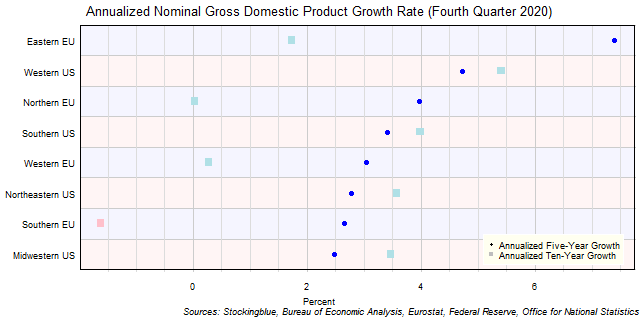
The chart above shows the annualized nominal gross domestic product (GDP) growth rate when priced in US dollars in each EU and US region over the past five years as of the fourth quarter of 2020 and the growth over the past ten years. The Southern EU was the only region that did not experience growth over the past ten years.
Findings
- The difference between the region with the largest annualized five-year growth rate, the Eastern EU, and the region with the smallest, the Midwestern US, is 4.91 percentage points.
- The difference between the region with the largest annualized ten-year growth rate, the Western US, and the region with the smallest, the Southern EU, is 7.03 percentage points.
- Of the eight regions, 4 (4 EU, 0 US) grew faster over the past five years than they did over the past ten years, 0 had the same annualized growth rate over both periods, and 4 (0 EU, 4 US) grew slower over the past five years than they did over the past ten years.
- All EU drops in growth rate are attributed to currency rate fluctuations.
Caveats
- Data is from the fourth quarters of 2010, 2015, and 2020.
- The data is seasonally adjusted in current dollars.
- Euros are converted to dollars at an average exchange rate of 1.19 for the fourth quarter of 2020, 1.09 for the fourth quarter of 2015, and 1.48 for the fourth quarter of 2010 according to historic rates listed at the Federal Reserve (see source link below).
- US data comes in an annualized format which the EU does not, thus EU data is annualized by multiplying the quarterly figure by four.
- US growth rates may differ from those provided by the Bureau of Economic Analysis as the BEA's growth rates are based on chained dollars in conjunction with the chain index or the quality index for real GDP. The growth rates listed here are based on nominal GDP.
- All figures are rounded to the nearest hundredth.
- The Eastern EU consists of Poland, Czech Republic, Romania, Hungary, Slovakia, Bulgaria, Croatia, Slovenia, Lithuania, Latvia, and Estonia.
- The Midwestern US consists of Illinois, Ohio, Michigan, Indiana, Minnesota, Wisconsin, Missouri, Iowa, Kansas, Nebraska, North Dakota, and South Dakota.
- The Northeastern US consists of New York, Pennsylvania, New Jersey, Massachusetts, Maryland, Connecticut, New Hampshire, Delaware, Maine, Rhode Island, and Vermont.
- The Northern EU consists of Sweden, Denmark, and Finland.
- The Southern EU consists of Italy, Spain, Portugal, Greece, Cyprus, and Malta.
- The Southern US consists of Texas, Florida, Georgia, North Carolina, Virginia, Tennessee, Louisiana, South Carolina, Alabama, Kentucky, Oklahoma, Arkansas, Mississippi, and West Virginia.
- The Western EU consists of Germany, United Kingdom, France, Netherlands, Belgium, Austria, Ireland, and Luxembourg.
- The Western US consists of California, Washington, Colorado, Arizona, Oregon, Utah, Nevada, New Mexico, Hawaii, Idaho, Alaska, Montana, and Wyoming.
Details
The Midwestern US had the worst performance over the past five years with an annualized growth rate of 2.48%. The Eastern EU had the best performance with an annualized growth rate of 7.39%.
Over the past ten years, the Southern EU had the worst performance with a -1.62% drop in GDP while the Western US had the best performance with a 5.41% rise in GDP.
The Midwestern US had the worst change in its growth rate between its annualized ten-year growth and its annualized five-year growth slowing its rate by 0.99 percentage points. The Eastern EU had the best change in its growth rate between its annualized ten-year growth and its annualized five-year growth raising its rate by 5.66 percentage points.
The Northeastern US had the smallest range in annualized five-year growth rates with a low of 1.49% in Rhode Island to a high of 3.42% in Massachusetts. Conversely, the Western EU had the greatest range in annualized five-year growth rates with a low of -0.32% in the United Kingdom to a high of 9.65% in Ireland. Over the past ten years, the Northern EU had the smallest range in growth rates with a low of -0.09% in Finland and Sweden to a high of 0.33 in Denmark. The Southern EU on the other hand, had the greatest range of rates on a ten-year basis with a low of -3.92% in Greece to a high of 5.30% in Malta.
Sources
Federal Reserve. 2021. "Foreign Exchange Rates." Accessed March 31, 2021. https://www.federalreserve.gov/releases/g5/.
Office for National Statistics. 2021. "Gross Domestic Product at market prices: Current price: Seasonally adjusted £m - Office for National Statistics." Accessed March 31, 2021. https://www.ons.gov.uk/economy/grossdomesticproductgdp/timeseries/ybha/ukea.
US Bureau of Economic Analysis. 2021. "GDP by State." Accessed May 7, 2021. https://www.bea.gov/data/gdp/gdp-state.